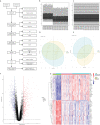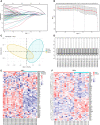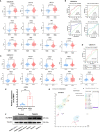Identification of immune-related endoplasmic reticulum stress genes in sepsis using bioinformatics and machine learning
- PMID: 36203606
- PMCID: PMC9530749
- DOI: 10.3389/fimmu.2022.995974
Identification of immune-related endoplasmic reticulum stress genes in sepsis using bioinformatics and machine learning
Abstract
Background: Sepsis-induced apoptosis of immune cells leads to widespread depletion of key immune effector cells. Endoplasmic reticulum (ER) stress has been implicated in the apoptotic pathway, although little is known regarding its role in sepsis-related immune cell apoptosis. The aim of this study was to develop an ER stress-related prognostic and diagnostic signature for sepsis through bioinformatics and machine learning algorithms on the basis of the differentially expressed genes (DEGs) between healthy controls and sepsis patients.
Methods: The transcriptomic datasets that include gene expression profiles of sepsis patients and healthy controls were downloaded from the GEO database. The immune-related endoplasmic reticulum stress hub genes associated with sepsis patients were identified using the new comprehensive machine learning algorithm and bioinformatics analysis which includes functional enrichment analyses, consensus clustering, weighted gene coexpression network analysis (WGCNA), and protein-protein interaction (PPI) network construction. Next, the diagnostic model was established by logistic regression and the molecular subtypes of sepsis were obtained based on the significant DEGs. Finally, the potential diagnostic markers of sepsis were screened among the significant DEGs, and validated in multiple datasets.
Results: Significant differences in the type and abundance of infiltrating immune cell populations were observed between the healthy control and sepsis patients. The immune-related ER stress genes achieved strong stability and high accuracy in predicting sepsis patients. 10 genes were screened as potential diagnostic markers for sepsis among the significant DEGs, and were further validated in multiple datasets. In addition, higher expression levels of SCAMP5 mRNA and protein were observed in PBMCs isolated from sepsis patients than healthy donors (n = 5).
Conclusions: We established a stable and accurate signature to evaluate the diagnosis of sepsis based on the machine learning algorithms and bioinformatics. SCAMP5 was preliminarily identified as a diagnostic marker of sepsis that may affect its progression by regulating ER stress.
Keywords: SCAMP5; endoplasmic reticulum stress; immunity; machine learning; sepsis.
Copyright © 2022 Gong, Liu, Tian, Zhang, Gao, Peng, Yin, Cheung and Liu.
Conflict of interest statement
The authors declare that the research was conducted in the absence of any commercial or financial relationships that could be construed as a potential conflict of interest.
Figures










Similar articles
-
Role of immune-related endoplasmic reticulum stress genes in sepsis-induced cardiomyopathy: Novel insights from bioinformatics analysis.PLoS One. 2024 Dec 13;19(12):e0315582. doi: 10.1371/journal.pone.0315582. eCollection 2024. PLoS One. 2024. PMID: 39671358 Free PMC article.
-
Identification of endoplasmic reticulum stress-related biomarkers of diabetes nephropathy based on bioinformatics and machine learning.Front Endocrinol (Lausanne). 2023 Sep 1;14:1206154. doi: 10.3389/fendo.2023.1206154. eCollection 2023. Front Endocrinol (Lausanne). 2023. PMID: 37745718 Free PMC article.
-
Comprehensive integration of diagnostic biomarker analysis and immune cell infiltration features in sepsis via machine learning and bioinformatics techniques.Front Immunol. 2025 Mar 10;16:1526174. doi: 10.3389/fimmu.2025.1526174. eCollection 2025. Front Immunol. 2025. PMID: 40129981 Free PMC article.
-
Identification of diagnostic candidate genes in COVID-19 patients with sepsis.Immun Inflamm Dis. 2024 Oct;12(10):e70033. doi: 10.1002/iid3.70033. Immun Inflamm Dis. 2024. PMID: 39377750 Free PMC article.
-
Sepsis biomarkers and diagnostic tools with a focus on machine learning.EBioMedicine. 2022 Dec;86:104394. doi: 10.1016/j.ebiom.2022.104394. Epub 2022 Dec 2. EBioMedicine. 2022. PMID: 36470834 Free PMC article. Review.
Cited by
-
Elucidating common pathogenic transcriptional networks in infective endocarditis and sepsis: integrated insights from biomarker discovery and single-cell RNA sequencing.Front Immunol. 2024 Jan 25;14:1298041. doi: 10.3389/fimmu.2023.1298041. eCollection 2023. Front Immunol. 2024. PMID: 38332910 Free PMC article.
-
Identification of KCNQ1 as a diagnostic biomarker related to endoplasmic reticulum stress for intervertebral disc degeneration based on machine learning and experimental evidence.Medicine (Baltimore). 2024 Nov 29;103(48):e40661. doi: 10.1097/MD.0000000000040661. Medicine (Baltimore). 2024. PMID: 39612444 Free PMC article.
-
Identification of the Shared Gene Signatures of HCK, NOG, RNF125 and Biological Mechanism in Pediatric Acute Lymphoblastic Leukaemia and Pediatric Sepsis.Mol Biotechnol. 2025 Jan;67(1):80-90. doi: 10.1007/s12033-023-00979-6. Epub 2023 Dec 20. Mol Biotechnol. 2025. PMID: 38123749 Free PMC article.
-
Utilizing integrated bioinformatics and machine learning approaches to elucidate biomarkers linking sepsis to purine metabolism-associated genes.Sci Rep. 2025 Jan 2;15(1):353. doi: 10.1038/s41598-024-82998-0. Sci Rep. 2025. PMID: 39747316 Free PMC article.
-
Bioinformatics-led discovery of ferroptosis-associated diagnostic biomarkers and molecule subtypes for tuberculosis patients.Eur J Med Res. 2023 Oct 19;28(1):445. doi: 10.1186/s40001-023-01371-5. Eur J Med Res. 2023. PMID: 37853432 Free PMC article.
References
-
- Hsu CY, Tsai YH, Lin CY, Chang YC, Chen HC, Chang YP, et al. . Application of a 72 h national early warning score and incorporation with sequential organ failure assessment for predicting sepsis outcomes and risk stratification in an intensive care unit: A derivation and validation cohort study. J Pers Med (2021) 11(9):910–24. doi: 10.3390/jpm11090910 - DOI - PMC - PubMed
-
- Rudd KE, Johnson SC, Agesa KM, Shackelford KA, Tsoi D, Kievlan DR, et al. . Global, regional, and national sepsis incidence and mortality, 1990-2017: Analysis for the global burden of disease study. Lancet (London England). (2020) 395(10219):200–11. doi: 10.1016/s0140-6736(19)32989-7 - DOI - PMC - PubMed
Publication types
MeSH terms
Substances
LinkOut - more resources
Full Text Sources
Medical

